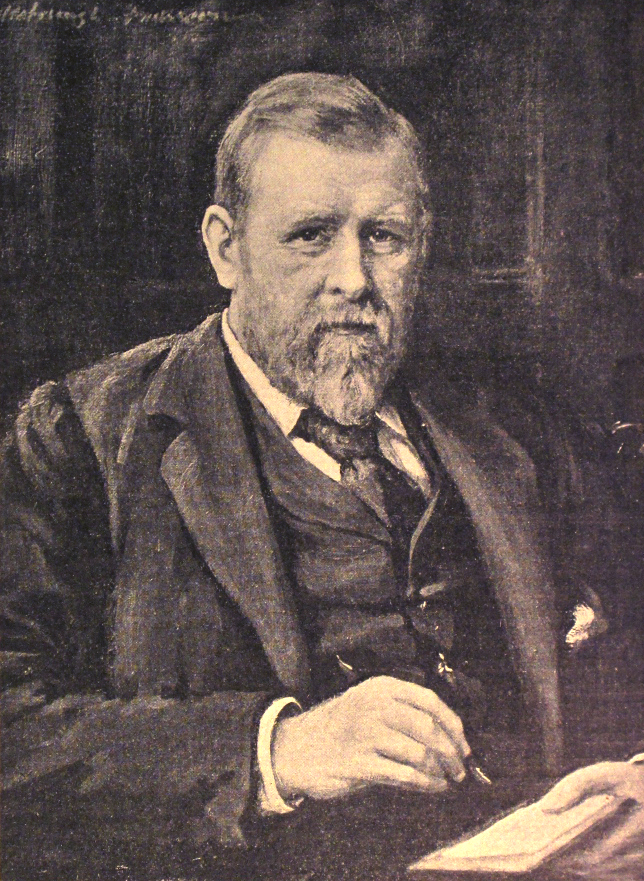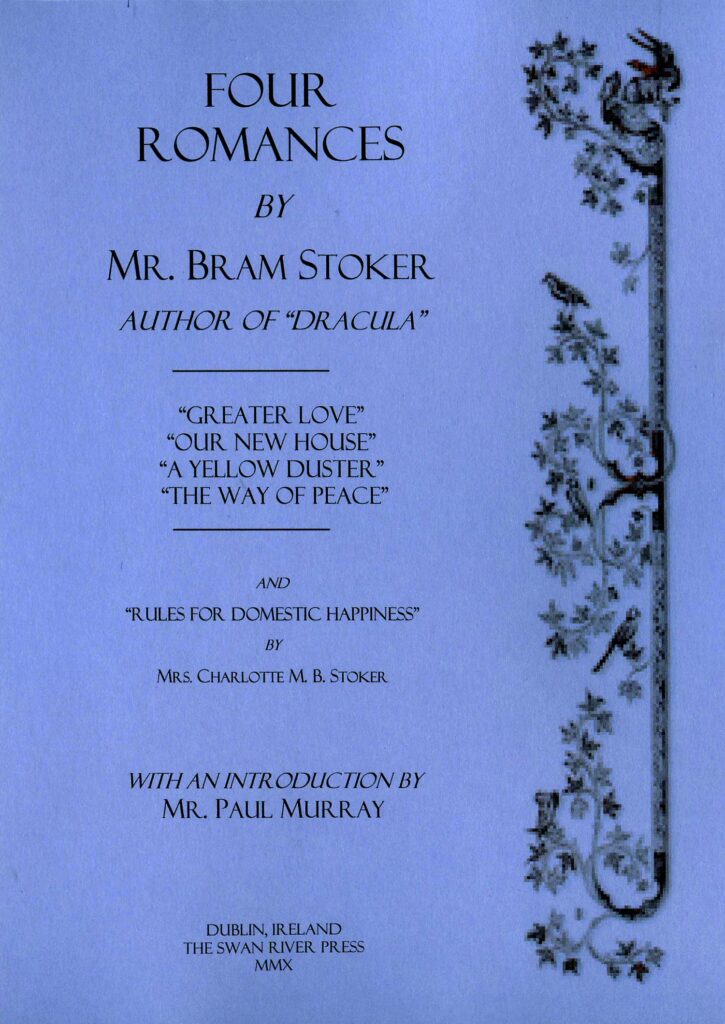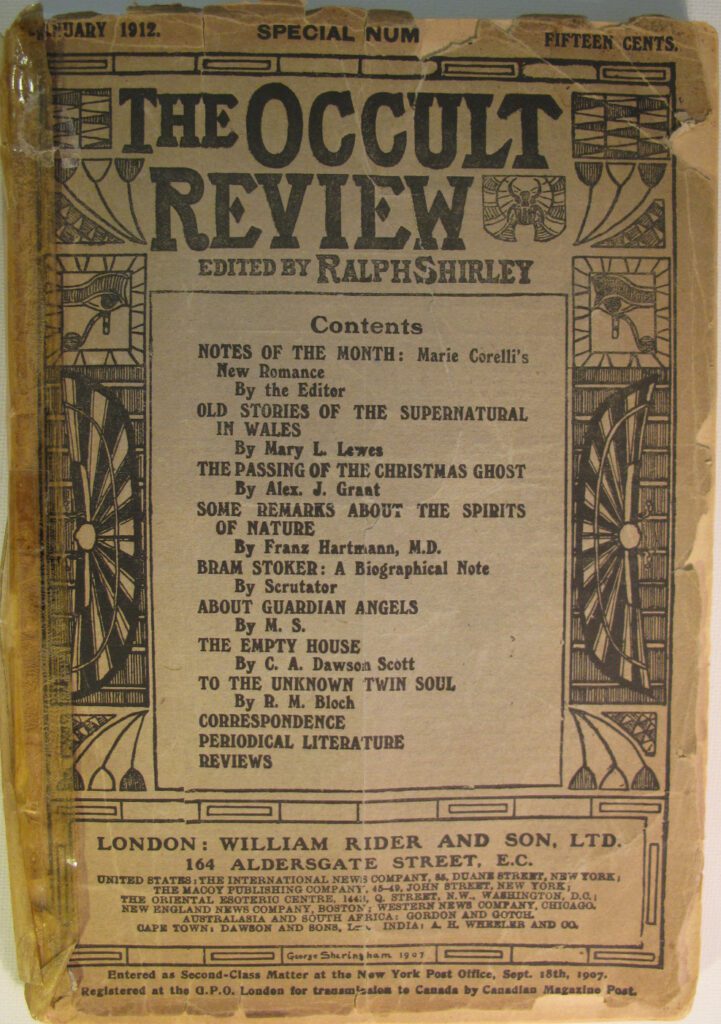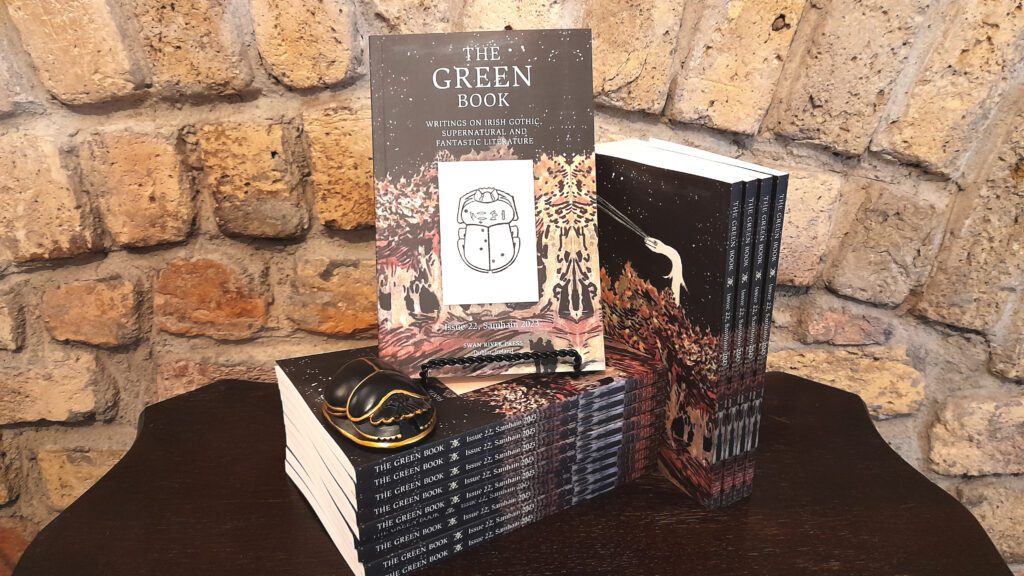 “Editor’s Note”
“Editor’s Note”
I thought this moment might never come. Perhaps on some levels I was even avoiding it due to an oversaturation of the blood-stained, opera-cloaked market. But at long last, we seem to have a Bram Stoker issue of The Green Book in our hands! Some of the keen-eyed might have realised this from the cover, which features as the background Pamela Colman Smith’s illustration for The Lair of the White Worm (1911), while the inset image is a detail from the printed boards of The Jewel of Seven Stars (1903). (It dawns on me as I write this that, while there is plenty of White Worm action herein, there’s nothing about Jewel—however, a scarab does make an appearance . . . )
The first piece in this issue is an appreciation of “The Judge’s House” (1891), and an accompanying illustration, by Mike Mignola, a writer and artist whose memorable creation Hellboy boasts direct lineage from the works of Stoker. This short essay first appeared as the introduction to the Swan River booklet The Definitive Judge’s House (2011), now long out of print. I thought it might be nice to give it another outing.
Next is another personal reminiscence transcribed from a lecture given by Leslie Shepard in 2000. In it, Shepard describes a situation familiar to many book collectors: the rare volume that “got away”. Shepard also outlines a mystery about Stoker, the first of three Stoker-related mysteries to be found in this issue. Those of a certain vintage might recall that Leslie Shepard co-founded the Bram Stoker Society, here in Dublin, in 1980. We’ll come back to the Bram Stoker Society in a moment.
 Douglas A. Anderson submitted a year ago an uncollected piece entitled “Black Spirits and White” by Henry Irving—or perhaps not? As Anderson conjectures in his brief note introducing the tale, there is a possibility that Stoker himself might have penned the piece (Mystery #2). Alas, we will likely never learn the answer, however you’re welcome to draw your own conclusion.
Douglas A. Anderson submitted a year ago an uncollected piece entitled “Black Spirits and White” by Henry Irving—or perhaps not? As Anderson conjectures in his brief note introducing the tale, there is a possibility that Stoker himself might have penned the piece (Mystery #2). Alas, we will likely never learn the answer, however you’re welcome to draw your own conclusion.
After this, we’re reprinting in its entirety another Swan River booklet from the out-of-print Stoker Series: Four Romances by Mr. Bram Stoker (2009). Paul Murray introduces the quartet of stories, noting that they showcase a different side to Stoker’s literary output than readers might be used to: the domestic drama. Augmenting this selection is a short piece by Stoker’s mother, Charlotte, and her rules for domestic happiness. The title pretty much says it all. (As an aside, I posited in the preface to Old Hoggen and Other Adventures (2017) that Stoker might have been planning a collection of “romance” stories prior to his death. For the curious, this volume might have contained stories such as “When the Sky Rains Gold” (1894), “Bengal Roses” (1898), “A Young Widow” (1899), and three of the four stories included in this issue—“Our New House” sneaked its way into Old Hoggen as an adventure. Who the audience is for an entire collection of Stoker’s romances, curious though they may be to the scholar, I am not entirely certain. Anyhow, see what you think.)
 I hope you’ll allow me a further indulgence, but I’m running one of my own articles in this issue—an essay with which readers of the late, lamented journal Wormwood might already be familiar. In “Bram Stoker and Another Dracula”, I discuss whether or not Stoker ever intended to write a sequel to Dracula (Mystery #3). It’s a question that fascinates me, and I think I’ve come up with a pretty good answer—but we can never know for sure. This essay was inspired by a paraphrased “interview” with Stoker that appeared in an issue of The Occult Review, just months before his passing in April 1912. In this piece, Mr. Stoker divulges some curious titbits, which I make use of in my own essay. I won’t spoil the surprise, but I thought it worth reprinting this interview in its entirety as well.
I hope you’ll allow me a further indulgence, but I’m running one of my own articles in this issue—an essay with which readers of the late, lamented journal Wormwood might already be familiar. In “Bram Stoker and Another Dracula”, I discuss whether or not Stoker ever intended to write a sequel to Dracula (Mystery #3). It’s a question that fascinates me, and I think I’ve come up with a pretty good answer—but we can never know for sure. This essay was inspired by a paraphrased “interview” with Stoker that appeared in an issue of The Occult Review, just months before his passing in April 1912. In this piece, Mr. Stoker divulges some curious titbits, which I make use of in my own essay. I won’t spoil the surprise, but I thought it worth reprinting this interview in its entirety as well.
I’m sad to report the passing in October 2022 of David Lass, who, along with Leslie Shepard and John Leahy, co-founded the Bram Stoker Society at Trinity College Dublin. An early member of the society, Albert Power, who was present for its inaugural meeting, has provided a memorial tribute to David Lass.
And so I would like to dedicate this issue to not only David, but also Leslie and John. Along with the aforementioned Wormwood, the journal of the Bram Stoker Society was a definitive inspiration for The Green Book.
And finally, to all those aficionados of The Jewel of Seven Stars: better luck next time.
Brian J. Showers
Æon House, Dublin
12 July 2023


No Comments yet!